Brief

At a Glance
- Bain research shows that some medtech companies are more likely to outperform their peers during and after the Covid-19 crisis. These winning firms are category leaders.
- With hospitals seeking to ensure quality, consistency of supply and a long-term partnership as they reduce the number of vendors they use, leaders in each individual category are likely to win market share.
- At this point in time, it’s imperative for medtech management teams to understand category leadership and employ it as a powerful tool for portfolio strategy and M&A choices.
In the wake of the pandemic, medtech leadership teams rightly have focused their time and energy on adapting to a permanently altered healthcare landscape. Providers are reassessing how they deliver care, how they interact with patients and how best to procure supplies. In response, medtech leaders are developing virtual selling strategies for differentiated go-to-market models and rethinking their product portfolios for a post-pandemic world by embracing new trends such as digital health.
When we finally emerge from the chaos of Covid-19, how will the competitor landscape shake out? Bain research shows that some medtech companies are more likely to outperform their peers during and after the crisis. These winning firms are category leaders. They seek to excel in the targeted segments in which they play as opposed to applying a broader brushstroke. They strategically concentrate on markets defined through the eyes of the customer, including patients, surgeons and payers. By developing products for a defined set of end users, category leaders avoid complex, wide-ranging portfolios that undermine focus.
After the 2008 global financial crisis, from 2010 to 2015, category leaders grew at a 5% compound annual growth rate (CAGR) compared with zero growth among other medtech players (see Figure 1). What’s more, from 2007 through the decade following the downturn, leaders grew at an average 8% CAGR while the others stalled at 4%.
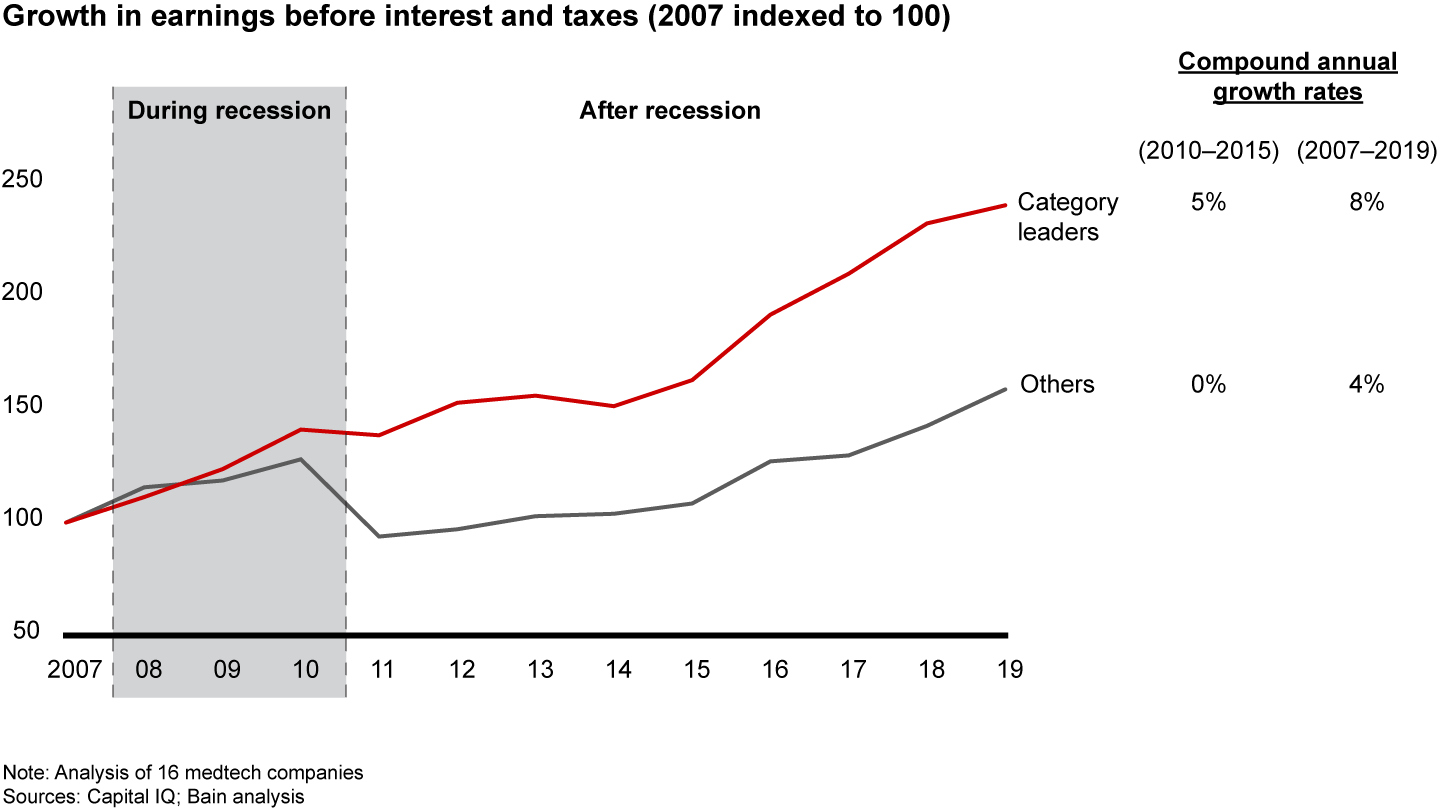
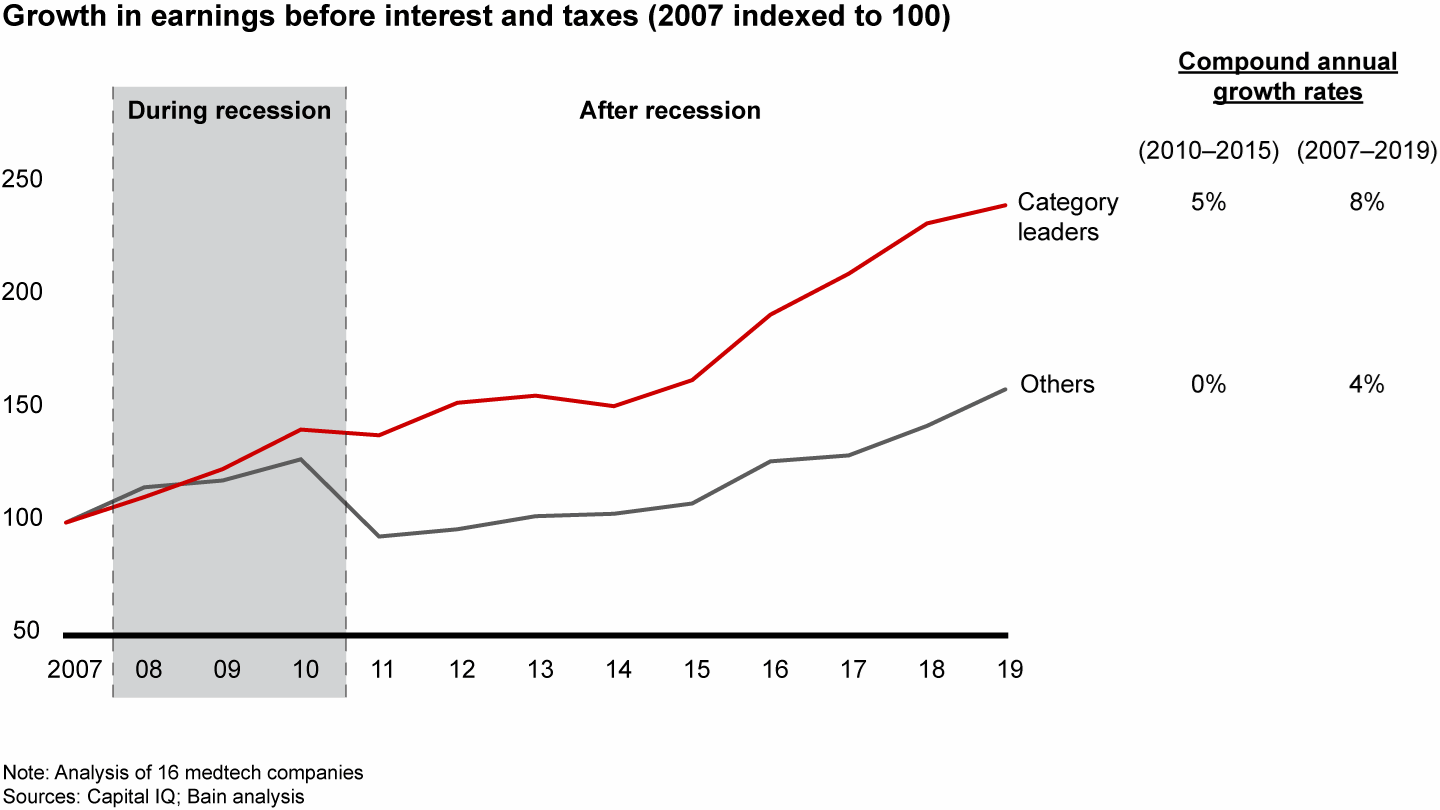
Category leaders’ targeted approach may sound counterintuitive: Classic strategy has long focused on building absolute scale. In most industries, there is a correlation between overall scale and profitability. Scale matters, the logic goes, because larger companies benefit from commercial influence and cost efficiencies.
In medtech, however, the correlation between scale and profitability actually is quite weak. Using Bain’s Category Leadership Index® (CLI) score, we quantified medtech companies’ leadership in the categories in which they compete. We compared the CLI scores with their relative market share (RMS), an indicator of scale, and what we found is telling: Profitability is more a function of category leadership. In fact, in 2019, there was almost no correlation between profitability and RMS, but there was a strong correlation between profitability and CLI (see Figure 2).
Consider a medtech company that holds follower positions across categories such as drug delivery, general surgery and cardiology. In part because of its follower positions, it falls below industry average earnings before interest and taxes margins. Similarly, another player holds weak positions in most of the categories in which it plays—including endoscopy; orthopedics; and ear, nose and throat—and it also sees lower-than-average profitability. Meanwhile, Edwards, which is close to both category followers in absolute scale, enjoys superior economics, thanks in part to its focus on market-leading positions in cardiac prosthetic devices as well as cardiovascular monitoring and diagnostic devices.
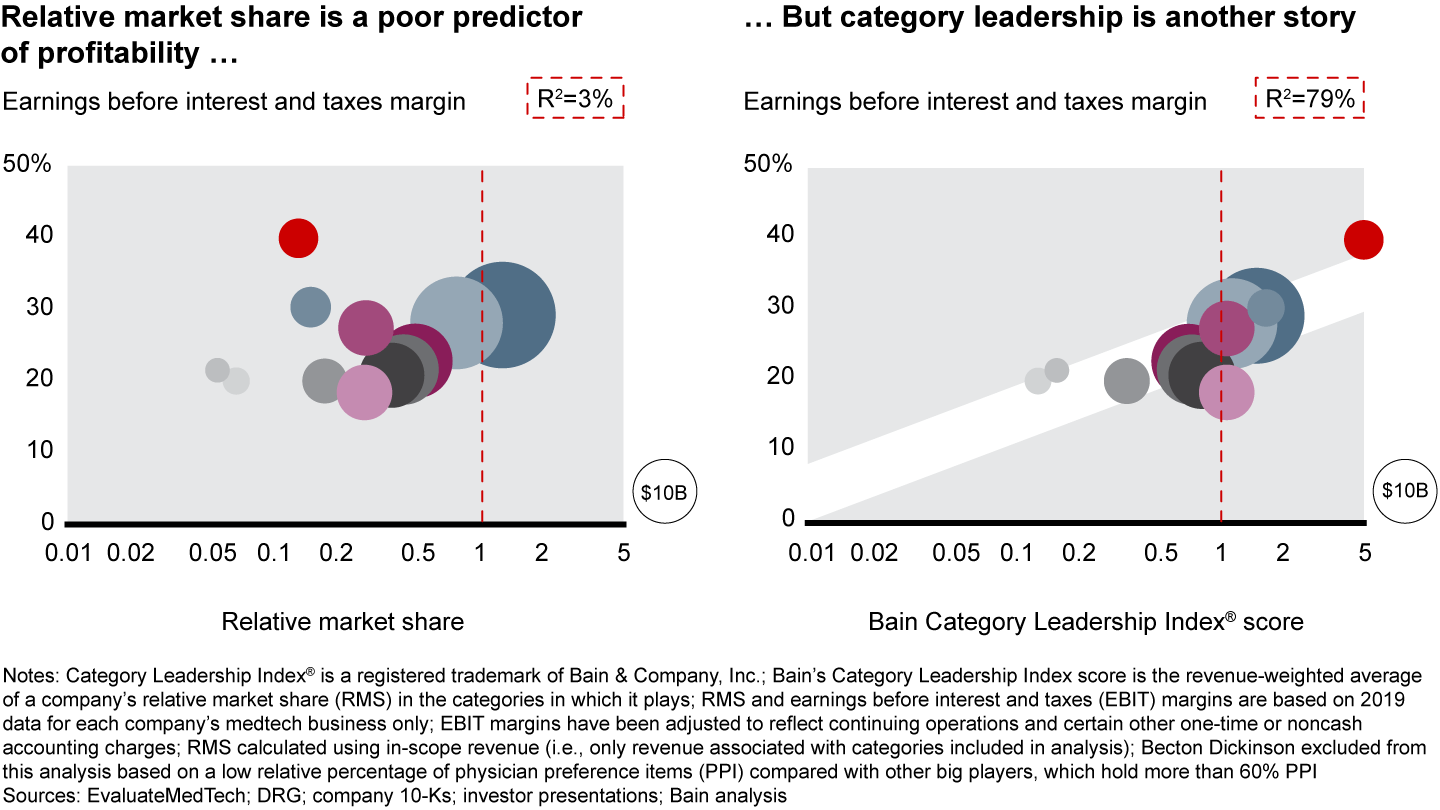
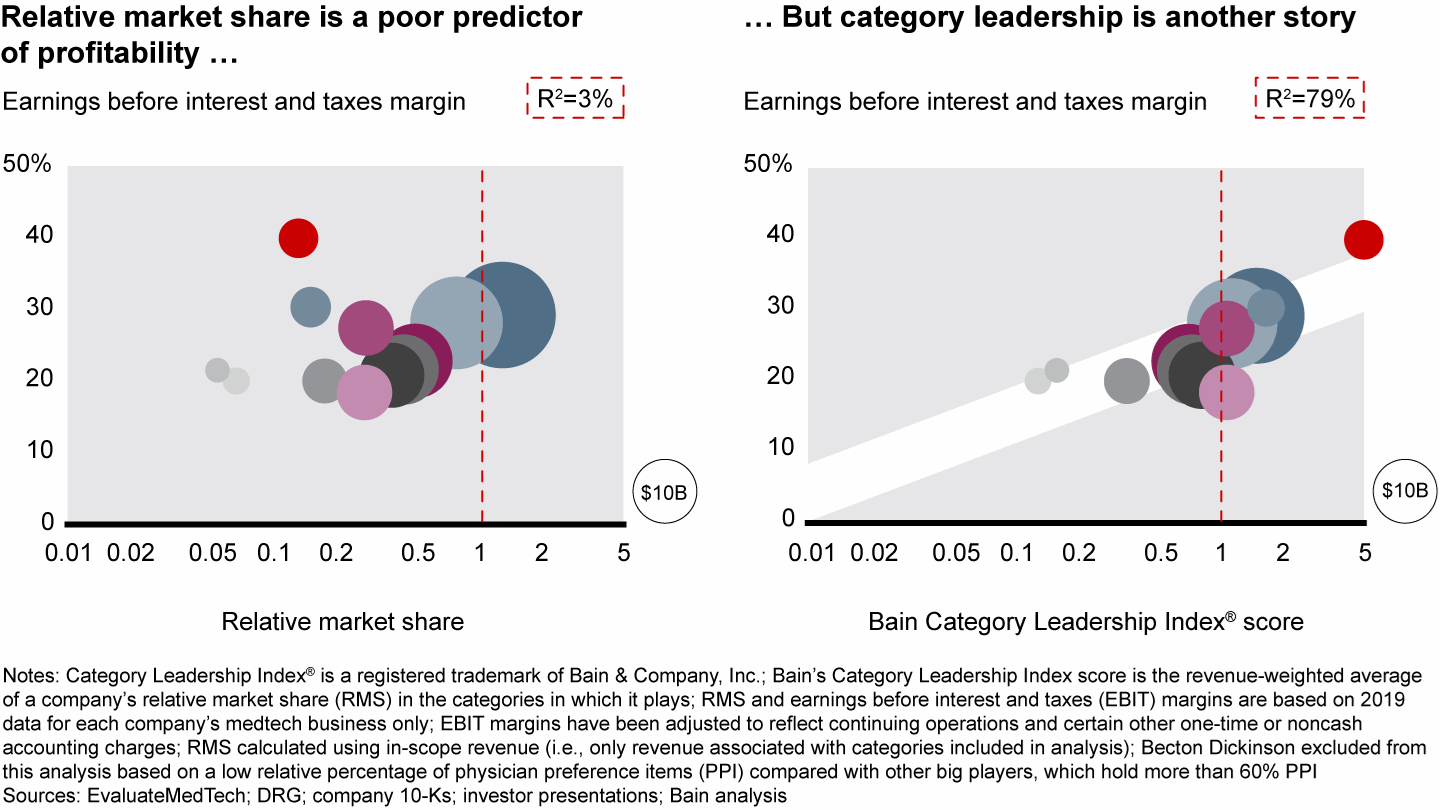
Why is medtech different from these other industries in which bigger means better? Some current trends would suggest that the pursuit of scale is an essential strategy for medtech organizations. The consolidation of healthcare providers over the past decade will only accelerate in the wake of the pandemic. The number of individual hospitals making medical device buying decisions continues to dwindle as large integrated delivery networks (IDNs) centralize purchasing.
Yet, as the medtech market becomes more competitive, providers and IDNs will show their preference for the leaders in each individual category. Category leaders will have a seat at the table with purchasers in the areas in which they excel but not across their entire portfolio. Winners will be the best of breed, and those with follower positions in multiple categories will continue to see diminished access and thus lower profitability.
For many medtech customers, category depth generates clinical expertise. This expertise, alongside solid, trusting relationships with physicians and strong procurement positioning, is essential to patient outcomes and valued by customers. And the importance of these factors is increasing: With hospitals seeking to ensure quality, consistency of supply and a long-term partnership as they reduce the number of vendors they use, category leaders are likely to win the flight to quality.
As medtech executives face the persisting economic shocks of Covid-19, the steadfast relevance of category leadership raises important questions for them regarding how to manage their product portfolios and make M&A decisions.
The renewed importance of category leadership
Today, category leadership matters more than ever. As the medtech market becomes more competitive amid pandemic-induced cost initiatives and consolidation, leaders will enjoy several critical advantages that category followers may find difficult to match or overcome.
Commercial clout. Nearly overnight, Covid-19 changed how medtech sales representatives interact with physicians, as on-site, in-person visits went virtual. And new protocols will likely endure even after a vaccine or treatment is available. According to a Bain survey, about 60% of providers believe that restrictions on medtech sales rep visits are likely to persist beyond the pandemic.
In-person interactions are key opportunities for medtech sales reps to build relationships with physicians. With powerful brand recognition and larger, more specialized salesforces, category leaders often reach more physicians, provide valuable support, and develop and maintain deeper customer relationships. Now, as more companies employ virtual selling tools and streamline their commercial models with clearer roles for sales and support, leaders are less likely to be encumbered by access restrictions than followers.
Category leaders are also in the best position to win the ensuing flight to quality. The decadelong trend of consolidation in healthcare is poised to continue: In response to declining revenue as a result of Covid-19, 95% of hospital administrators expect to roll out performance improvement initiatives, including preferred vendor consolidation (see Figure 3).
With their valued, specialized support, category leaders are more likely to survive this coming wave of vendor consolidation. And as provider systems continue to pursue value-based care, well-capitalized leaders will be more adept at implementing new payment models, such as risk-sharing agreements. Already, in light of the pandemic, some category leaders are providing innovative financing options to help customers manage their own cash constraints, strengthening those relationships along the way.
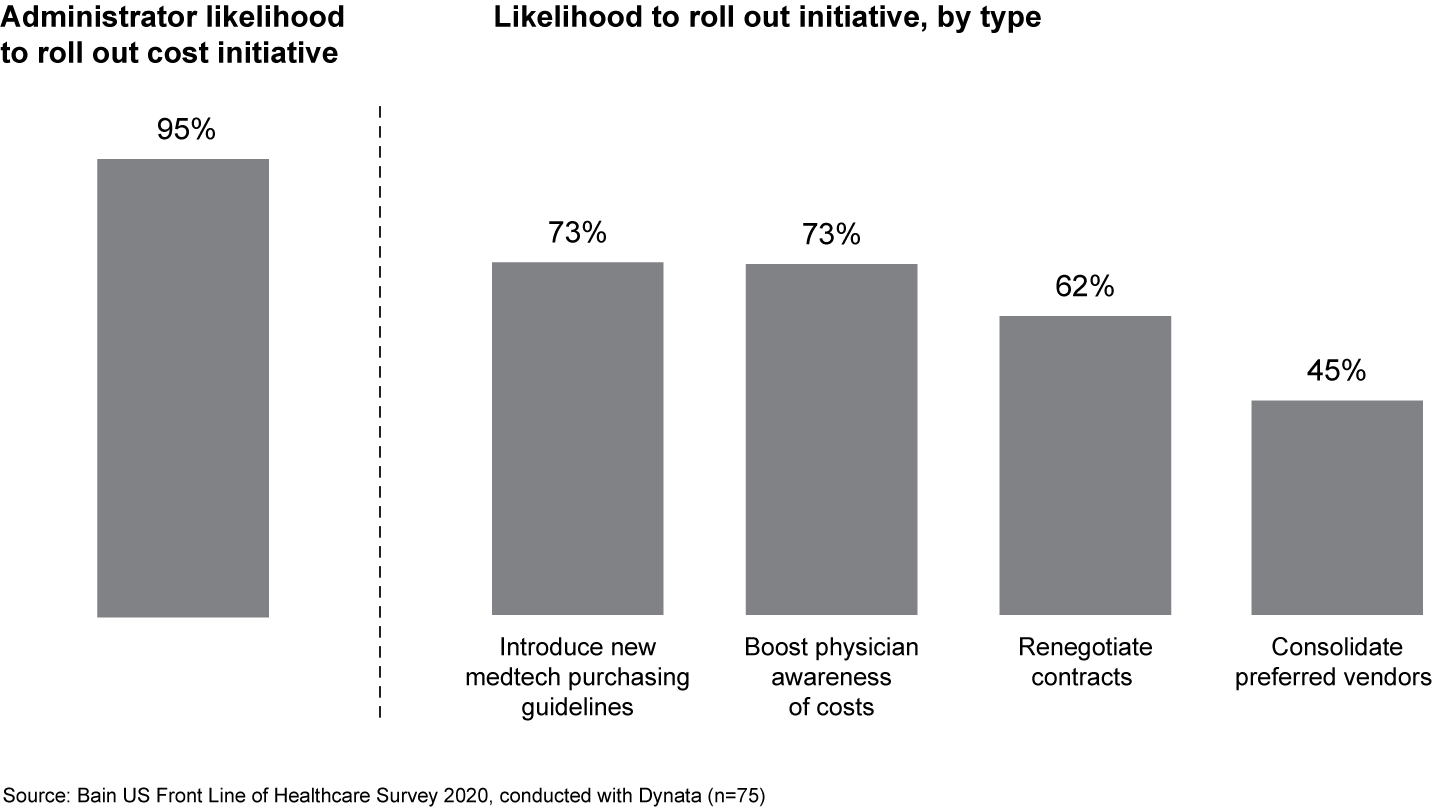
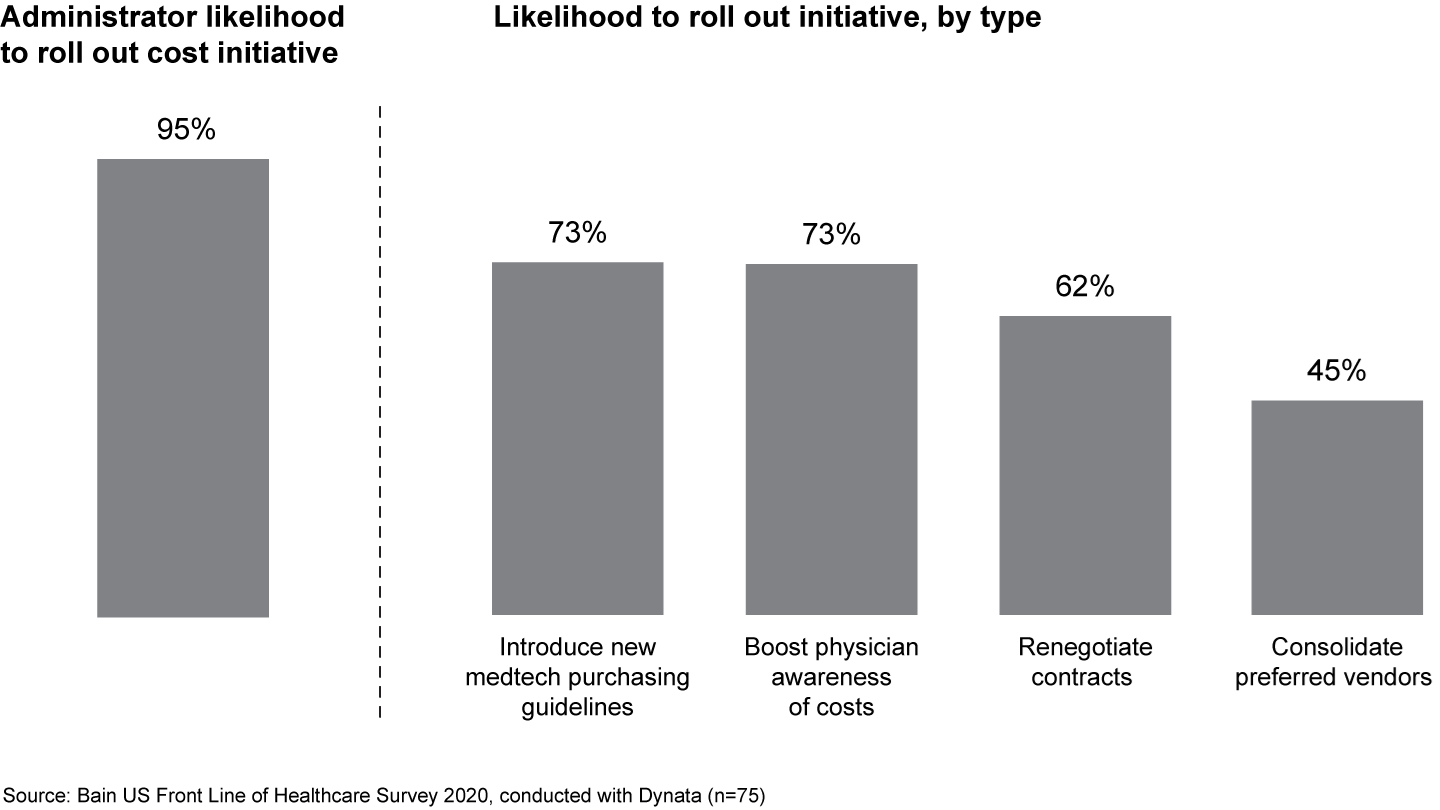
Clinical expertise. Industry leaders not only have sizable specialized salesforces but they also have deep category expertise that helps them forge strong relationships with physicians and buying organizations. They benefit from unparalleled insight into the perspectives of other key stakeholders as well, including nurses, technicians, procurement professionals and service line administrators. Through this invaluable network of connections, category leaders glean critical knowledge about their customers’ needs that they then use to guide R&D and innovation, continuing the flywheel of expertise.
Leaders are also more likely to have large, targeted key opinion leader (KOL) programs. KOL engagement has the power to position medtech companies as thought leaders in the medical community and can directly inform R&D. In 2010, the Physician Payments Sunshine Act imposed strict regulations on KOL programs, requiring medtech companies to report physician and hospital payments as well as value transfers to the Centers for Medicare and Medicaid Services. Yet category leaders were able to maintain their strong connections: They have the resources and relationships required to recruit field experts, comply with regulatory requirements and otherwise develop KOL programs as a critical input to innovative research.
M&A advantage. Over the past five years, we’ve seen numerous transactions in medtech sparked by the pursuit of category leadership. For instance, Stryker acquired Wright and K2M, fortifying its existing leadership positions in trauma and the extremities and spine categories, respectively. Boston Scientific focused on expanding its oncology and cardiovascular solutions with its acquisition of BTG in 2018.
Companies that view M&A through a category leadership lens are in a better position to deliver synergies. Consider Boston Scientific: The medical device leader expects to achieve $175 million in revenue and cost synergies from the BTG acquisition by 2022. What’s more, companies that reach category leadership will have an advantage in future acquisitions: They can justify paying a premium for related assets because they have more effective commercialization platforms.
The M&A advantage is especially relevant today as the industry considers facing the aftermath of Covid-19. Profitable category leaders can invest in organic and inorganic growth, emerging stronger on the other side of the downturn. During the Great Recession, for example, Covidien boosted its position in cardiology and patient monitoring with several 2009 and 2010 acquisitions. The 2010 acquisition of Ev3, a $2.6 billion vascular company, helped increase Covidien’s share in cardiology. Similarly, Covidien’s acquisition of Aspect Medical Systems and Somanetics, both makers of patient monitoring equipment, contributed to its strong position in the category.
Attaining the category leader advantage
While the pandemic has been unprecedented, the trajectory that category leaders will follow in the coming years is not. Similar to the way they accelerated coming out of the global financial crisis, category leaders will continue to pull away from the pack, investing through the downturn to gain share as demand returns. At this point in time, it’s imperative for medtech management teams to understand category leadership and their CLI score. In particular, the CLI score can be a powerful tool for portfolio strategy and M&A choices.
CLI scoring enables companies to take an objective look at their product portfolios. An assessment of strengths and weaknesses can help determine important trade-offs in resourcing and R&D. It can also inform possible divestitures in markets in which the chance of becoming a leader is limited. For instance, in 2018, Johnson & Johnson took another step toward exiting the diabetes delivery market with the divestiture of Lifescan, its glucose monitoring business. The company had previously exited the insulin pump market with the operational closure of Animas Corp in 2017. Bain analysis shows that the divestitures of the low-share, noncore diabetes device units increased Johnson & Johnson’s CLI.
Medtech players, which have historically grown through inorganic acquisitions and organic strategies, can use CLI scores to determine if a target is a good fit. They can also assess if the proposed deal will improve their category leadership position and economic returns. Take Abbott’s $25 billion acquisition of St. Jude in 2016. The deal increased the combined company’s CLI score from 0.31 to 0.67 by boosting its position in cardiology (see Figure 4). Abbott moved into the second place position in the category, up from the fifth.
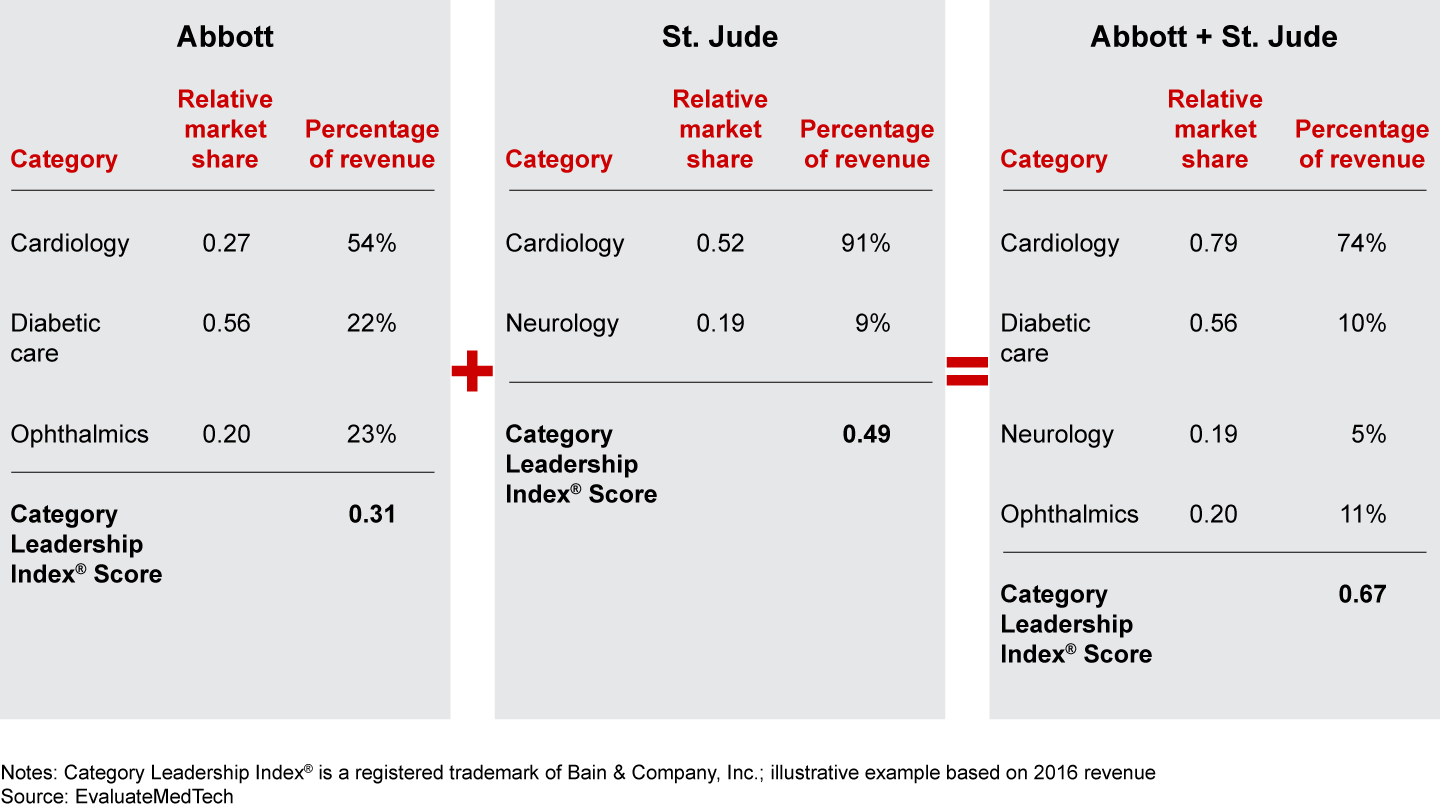
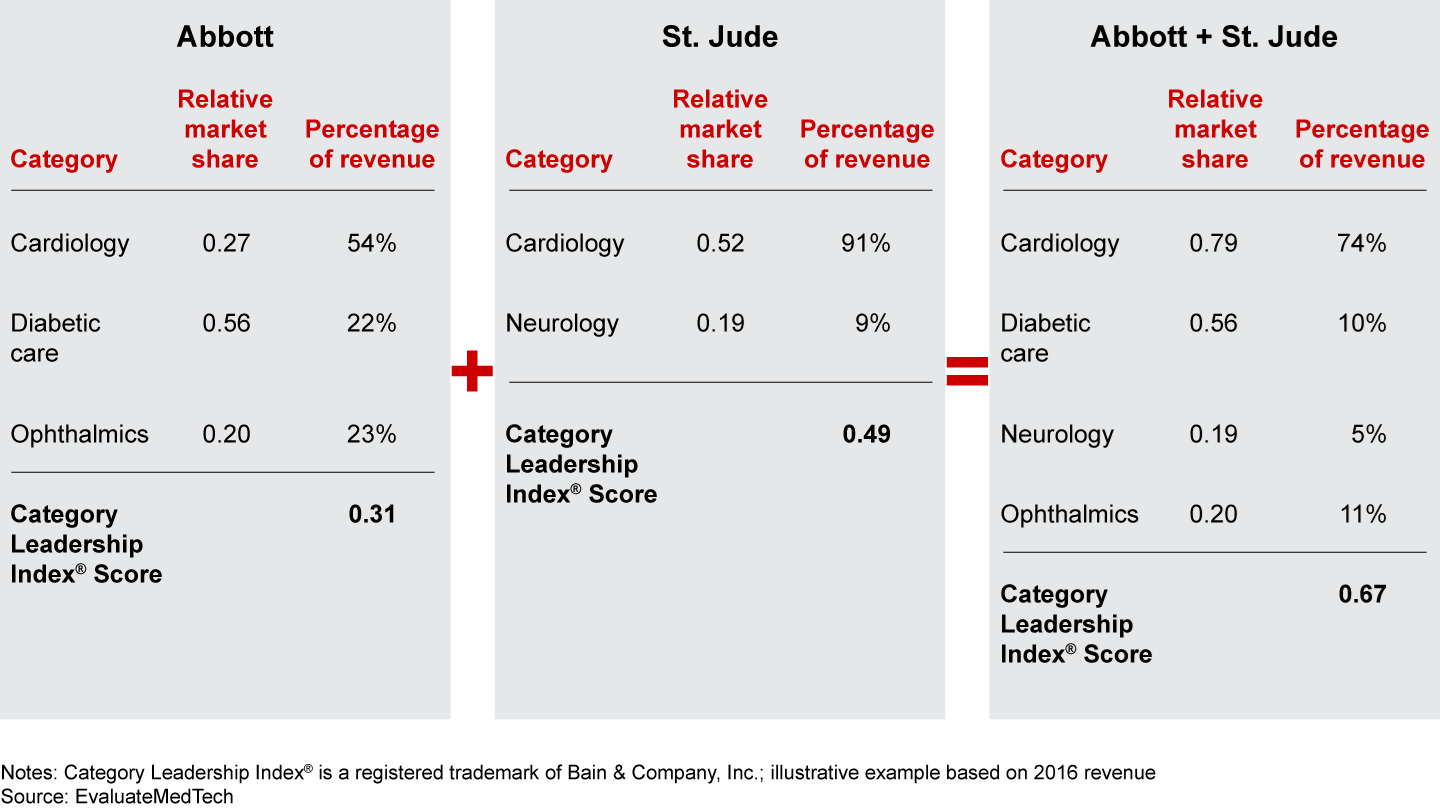
To better understand the implications of category leadership, executive teams can ask the following questions:
- What is the best way to define the categories in which we participate?
- What is our CLI score? How does it compare with our competitors?
- Which products in our portfolio help our CLI score? Which products hurt our CLI score?
- What organic and inorganic actions can we take to achieve category leadership growth?
- Which deals on our M&A roadmap will affect our CLI score and how? For upcoming transactions, are we buying a player with share in one of our existing categories? Are we buying a player with share in a new category? If so, do they have a strong leadership position? What’s the path to achieving post-acquisition leadership?
With a focus on category leadership, rather than scale, medtech companies can build market-leading positions and see attractive returns, accelerating ahead of the competition and out of the downturn.
Methodology
In order to test the correlation between category leadership and profitability, Bain created the CLI score, which measures the level of a company’s leadership across the portfolio of categories in which it competes. A company’s CLI score is the average of its RMS in the categories in which it conducts business, weighted by its percentage of total revenue in each category.
For this analysis, we looked exclusively at physician preference items, not commoditized products, because in those categories, customer preference matters and physicians maintain purchasing power. In addition, the CLI scores are inclusive of global market shares. Market shares can vary significantly, however, by region. Some medtech companies have built strong regional businesses so that they see lower global category share while also maintaining strong returns. Finally, this analysis is limited to companies that earn most of their revenue in the US because different regions have structurally different profitability profiles.
Category Leadership Index® is a registered trademark of Bain & Company, Inc.